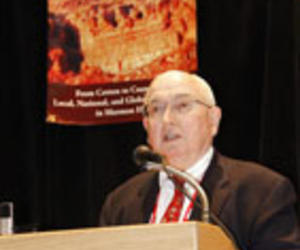President Buchanan contemplated using Brigham Young to acquire northern Mexico, Cuba
- Submitted by: manso
- Politics and Government
- 05 / 31 / 2011

Published: Sunday, May 29, 2011 10:46 p.m. MDT. By R. Scott Lloyd, Church News staff writer
ST. GEORGE — U.S. President James Buchanan contemplated using Brigham Young and the Mormons in a complex chain of events that would result in the acquisition by the United States of northern Mexico and Cuba, the president of the Mormon History Association said Saturday evening.
William P MacKinnon, ending his one-year term as the association head, delivered the traditional presidential address at the closing banquet for its annual conference in St. George over the weekend.
A Presbyterian by faith and a former General Motors executive by profession, MacKinnon is an expert on the Utah War. In 2008, he published "At Sword's Point," a documentary history of the events in 1857, when U.S. President James Buchanan, reacting to rumors from federal officials, sent an armed force to Utah to restore federal authority and replace Brigham Young as territorial governor.
In his address, MacKinnon also debunked a persistent bit of Mormon folklore pertaining to the march of the Army through Salt Lake City after a tenuous peace had been negotiated.
But it was the linkage of Buchanan's "Utah Expedition" with his designs on Mexico and Cuba to which MacKinnon devoted most of his address.
He presented recent research to show that late in the conflict with Brigham Young and the Mormons, Buchanan contemplated using soldiers already sent from the East and another army to be raised from the California coast to pressure the Mormons to flee to the region of Sonora, Mexico. With a "critical mass" of U.S. refugees thus in place, the United States could then annex the region, as had been done with Texas some 15 years earlier.
In a way that still remains a mystery, Buchanan's next step would be to acquire the Spanish colony of Cuba.
"How Buchanan could believe that a Mexican diaspora to Sonora, stimulated by pressure from a Utah Expedition reinforced from the Pacific Coast, would be willing to reaffiliate with the United States is an intriguing mystery," MacKinnon said. "Brigham Young had already been down that road, so to speak, after being driven out of Illinois" and being forced to settle in what was, at the time, Mexican territory in 1847.
"Ten years later, Young still chafed over the thought of an approaching Utah Expedition in the face of a history of LDS participation in the Mexican War through the U.S. Army's Mormon Battalion."
Even more elusive to understanding, MacKinnon said, are "the means by which Buchanan planned subsequently to spring from Mexico to his main objective: Cuba."
MacKinnon uncovered the linkage between the Utah War and Buchanan's territorial adventurism in the papers of Sir William Gore Ouseley, a British envoy and a confidant of Buchanan.
In 1857, en route to a new post in Central America, Ouseley stopped for a year in Washington. There, he became acquainted with Buchanan's secret plans regarding Mexico and Cuba.
Ouseley reported what he had learned to his superior in England, George William Frederick Villiers, 4th Earl of Clarendon. It was from an examination of Lord Clarendon's papers, on loan to the library at Oxford University in England that MacKinnon learned of Buchanan's confidential conversations with Oueseley.
"With this unexplored material at hand, students of the Utah War can now better understand the linkages between multiple events heretofore interpreted as unconnected," MacKinnon remarked.
He said it raises an important question: " Should historians now consider an additional conspiracy theory alongside the traditional ones that have lamentably troubled the Utah war's origins? I mean the possibility that Buchanan initiated the Utah Expedition in March 1857 to advance international expansion."
MacKinnon argued against such an interpretation.
"In brief, I believe that Buchanan's long-term pursuit of Mexico and Cuba were not factors in the Utah Expedition's origins," he said. "At that time, March 1857, replacing Brigham Young as governor and restoration of federal authority were the president's objectives. However, once Buchanan realized in mid-November 1857 that effective Mormon military resistance was a reality, and he would have to reinforce the Utah Expediton, armed confrontation in the Rockies provided a field for manipulation."
It stimulated Buchanan's more devious instincts and provided an opportunity "to scratch two presidential itches": solving the Mormon problem and fulfilling Manifest Destiny, MacKinnon said.
Earlier in his address, MacKinnon spoke of the Mormon folklore that as the U.S. Army was marching through Salt Lake City, Col. William St. George Cooke passed by the Beehive House residence of Brigham Young and doffed his hat in respect for the Mormon Battalion soldiers who had earlier served under his command.
MacKinnon said, in reality, it was the 10th Infantry's Col. Alexander who doffed his hat for some reason and it was to a small crowd of bystanders. This is according to written reports Young received from his military adjutant, James Ferguson, who was left in Salt Lake City to monitor the behavior of the federal troops.
Source: www.deseretnews.com/article/700140002/
Comments